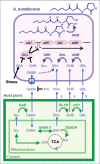A fine control of quorum-sensing communication in Agrobacterium tumefaciens
- PMID: 20585496
- PMCID: PMC2889960
- DOI: 10.4161/cib.3.2.10429
A fine control of quorum-sensing communication in Agrobacterium tumefaciens
Abstract
The bacterial pathogen Agrobacterium tumefaciens produces the quorum-sensing (QS) signal 3-oxo-octanoylhomoserine lactone (OC8HSL) for controlling horizontal transfer of its tumor inducing (Ti) plasmid that carries both the T-DNA and the virulence genes. Over-accumulation of OC8HSL also increases severity of plant symptoms (number of emerging tumors at infection site) by an unknown mechanism. A. tumefaciens strain C58 expresses two lactonases, AttM (BlcC) and AiiB, that cleave OC8HSL and are potential modulators of QS. Recent data highlight the direct contribution of lactonases AttM and AiiB in the control of OC8HSL level and QS-regulated functions such as conjugation of Ti plasmid and seriousness of plant symptoms. Expression of the two lactonases is regulated by different plant signals. A working model of QS in the course of the A. tumefaciens-plant host interaction is proposed and discussed.
Keywords: AiiB; AttM; GABA; agrocinopine; lactonase; proline; virulence.
Figures


Similar articles
-
Different regulation and roles of lactonases AiiB and AttM in Agrobacterium tumefaciens C58.Mol Plant Microbe Interact. 2009 May;22(5):529-37. doi: 10.1094/MPMI-22-5-0529. Mol Plant Microbe Interact. 2009. PMID: 19348571
-
Quorum Sensing and Quorum Quenching in Agrobacterium: A "Go/No Go System"?Genes (Basel). 2018 Apr 16;9(4):210. doi: 10.3390/genes9040210. Genes (Basel). 2018. PMID: 29659511 Free PMC article. Review.
-
The BlcC (AttM) lactonase of Agrobacterium tumefaciens does not quench the quorum-sensing system that regulates Ti plasmid conjugative transfer.J Bacteriol. 2009 Feb;191(4):1320-9. doi: 10.1128/JB.01304-08. Epub 2008 Nov 14. J Bacteriol. 2009. PMID: 19011037 Free PMC article.
-
The Ti plasmid of Agrobacterium tumefaciens harbors an attM-paralogous gene, aiiB, also encoding N-Acyl homoserine lactonase activity.Appl Environ Microbiol. 2003 Aug;69(8):4989-93. doi: 10.1128/AEM.69.8.4989-4993.2003. Appl Environ Microbiol. 2003. PMID: 12902298 Free PMC article.
-
Functions and regulation of quorum-sensing in Agrobacterium tumefaciens.Front Plant Sci. 2014 Jan 31;5:14. doi: 10.3389/fpls.2014.00014. eCollection 2014. Front Plant Sci. 2014. PMID: 24550924 Free PMC article. Review.
Cited by
-
Comparative Transcriptome Analysis of Agrobacterium tumefaciens Reveals the Molecular Basis for the Recalcitrant Genetic Transformation of Camellia sinensis L.Biomolecules. 2022 May 11;12(5):688. doi: 10.3390/biom12050688. Biomolecules. 2022. PMID: 35625616 Free PMC article.
-
Diverse Profiles of AI-1 Type Quorum Sensing Molecules in Cultivable Bacteria from the Mangrove (Kandelia obovata) Rhizosphere Environment.Front Microbiol. 2016 Dec 5;7:1957. doi: 10.3389/fmicb.2016.01957. eCollection 2016. Front Microbiol. 2016. PMID: 27994584 Free PMC article.
-
D101 is critical for the function of AttJ, a repressor of quorum quenching system in Agrobacterium tumefaciens.J Microbiol. 2015 Sep;53(9):623-32. doi: 10.1007/s12275-015-5100-x. Epub 2015 Aug 1. J Microbiol. 2015. PMID: 26231372
-
The Agrobacterium Ti Plasmids.Microbiol Spectr. 2014 Dec;2(6):10.1128/microbiolspec.PLAS-0010-2013. doi: 10.1128/microbiolspec.PLAS-0010-2013. Microbiol Spectr. 2014. PMID: 25593788 Free PMC article. Review.
-
Friends or Foes-Microbial Interactions in Nature.Biology (Basel). 2021 Jun 2;10(6):496. doi: 10.3390/biology10060496. Biology (Basel). 2021. PMID: 34199553 Free PMC article. Review.
References
-
- Escobar MA, Dandekar AM. Agrobacterium tumefaciens as an agent of disease. Trends Plant Sci. 2003;8:380–386. - PubMed
-
- Pappas KM, Winans SC. A LuxR-type regulator from Agrobacterium tumefaciens elevates Ti plasmid copy number by activating transcription of plasmid replication genes. Mol Microbiol. 2003;48:1059–1073. - PubMed
-
- Molina L, Constantinescu F, Michel L, Reimmann C, Duffy B, Défago G. Degradation of pathogen quorum-sensing molecules by soil bacteria: a preventive and curative biological control mechanism. FEMS Microbiol Ecol. 2003;45:71–81. - PubMed
LinkOut - more resources
Full Text Sources
